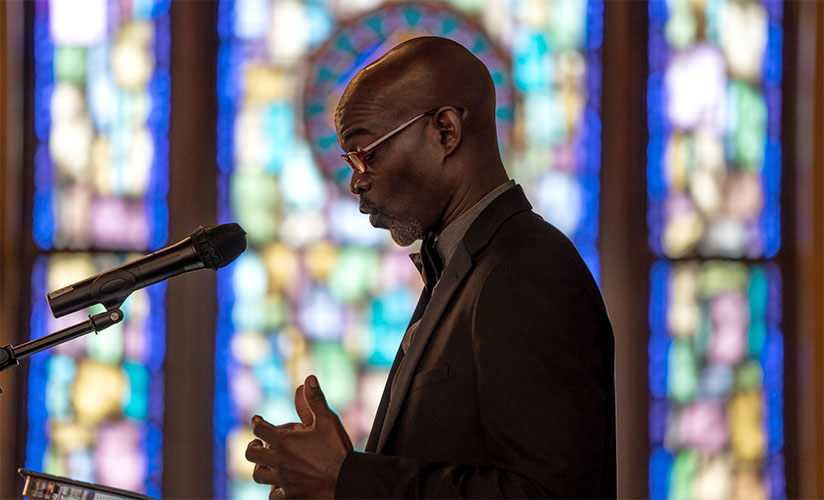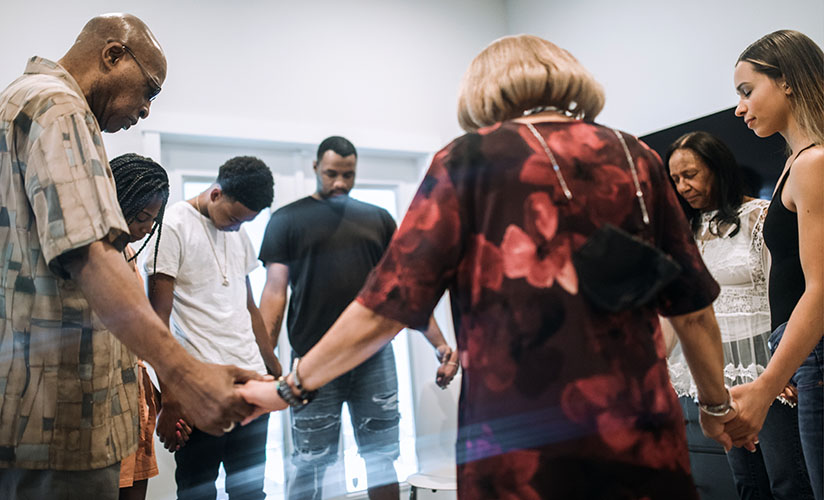Como iglesias, nuestro llamado principal es servir y amar a todas las personas, independientemente de sus antecedentes, capacidades o circunstancias. Sin embargo, crear entornos verdaderamente inclusivos requiere más que una política de puertas abiertas. Implica esfuerzos intencionales para fomentar la accesibilidad, tanto física como emocional, de modo que cada miembro, visitante y asistente se sienta bienvenido, valorado y seguro.
En esta publicación, exploraremos algunas formas prácticas en que los administradores y pastores de la iglesia pueden hacer que sus iglesias sean más inclusivas, enfocándose en los aspectos físicos de la accesibilidad, así como en la seguridad emocional y cultivando una cultura eclesial no tóxica.

Accesibilidad física: Cómo hacer que su iglesia sea acogedora para todos
En una iglesia verdaderamente inclusiva, nadie debería sentir que el espacio físico es una barrera para el culto o la participación. A continuación, se indican varios cambios clave que pueden mejorar la accesibilidad en su iglesia.
Asientos accesibles para personas discapacitadas
Las iglesias deben ofrecer opciones de asientos accesibles para personas que usan andadores, bastones, sillas de ruedas u otros dispositivos de movilidad. Asegúrese de que haya espacios designados para sillas de ruedas u otros dispositivos de movilidad, especialmente en áreas donde la congregación suele reunirse (como el santuario o el salón de usos múltiples). Estos espacios no deben ser una idea de último momento, sino que deben integrarse en el diseño de una manera que permita que las personas con discapacidades se sientan parte de la congregación en lugar de apartadas. El uso de sillas Bertolini en el santuario de su iglesia facilita la adaptación de personas con discapacidades. Simplemente agregue o quite sillas según sea necesario para hacer espacio para sillas de ruedas.

Pasillos y portales anchos de la iglesia
Tenga en cuenta el ancho de los pasillos y las puertas. Una renovación sencilla, como ampliar los pasillos y las puertas de entrada, puede suponer una gran diferencia para una persona en silla de ruedas o que usa un andador. Asegúrese de que haya suficiente espacio para que las personas puedan moverse cómodamente, sin necesidad de pasar entre otros asistentes o muebles. Sillas de iglesia Bertolini Son apilables y livianas, lo que las hace fáciles de mover. Se pueden agregar, quitar y reubicar filas de sillas Bertolini fácilmente para que haya suficiente espacio libre para los feligreses con discapacidades.
Entradas accesibles
Si bien la mayoría de las iglesias tienen al menos una entrada accesible con rampa, es fundamental asegurarse de que esté claramente marcada y sea de fácil acceso. Si la entrada principal de su iglesia no es accesible para sillas de ruedas, considere crear una entrada alternativa que sí lo sea. También es importante verificar el estado de las rampas y las barandillas laterales y asegurarse de que sean resistentes y estén libres de obstrucciones.

Baños e Instalaciones
Los baños accesibles son otro elemento importante que se necesita para que las iglesias incluyan a las personas con discapacidades. Verifique que los baños de su iglesia tengan las estructuras de apoyo adecuadas (por ejemplo, barras de apoyo) y sean lo suficientemente grandes como para acomodar dispositivos de movilidad como sillas de ruedas o andadores. Si el espacio lo permite, considere la posibilidad de tener baños familiares disponibles también, lo que puede ser útil para padres con niños o cuidadores. Se pueden agregar letreros de baños en braille para ayudar a las personas con discapacidad visual.
Plazas de aparcamiento
Asegúrese de que haya espacios de estacionamiento designados para discapacitados cerca de la entrada de la iglesia. Lo ideal es que haya suficiente espacio para acomodar varios vehículos, especialmente durante eventos o servicios más grandes. Estos espacios deben estar claramente marcados y libres de obstrucciones.
Subtítulos e intérpretes de lenguaje de señas
Según una publicación reciente del Instituto Nacional de Salud, el 14% de los adultos (de 20 a 69 años) en Estados Unidos informan algún tipo de pérdida auditiva, y ese porcentaje aumenta con la edad.1 Cuando los estadounidenses alcancen la edad de 75 años o más, casi la mitad tendrá pérdida auditiva relacionada con la edad.1 Desde un punto de vista práctico, lo que esto significa para las iglesias es que hay muchas personas en la congregación que podrían beneficiarse de las tecnologías de asistencia.
Puede hacer que el mensaje de su iglesia esté disponible para personas con pérdida auditiva si contrata a un intérprete de lenguaje de señas para que lo haga, aunque esto no será de ayuda para quienes tienen pérdida auditiva relacionada con la edad y no han aprendido el lenguaje de señas. Las iglesias grandes con transmisiones en vivo pueden activar los subtítulos generados por IA. Otra forma popular de ayudar a las personas con pérdida auditiva es instalar un sistema de circuito cerrado (un sistema de bucle auditivo), que transmite el sonido desde el micrófono directamente a los audífonos de la audiencia. Otra opción que puede sugerir es que los feligreses utilicen una aplicación de voz a texto en vivo.

Las iglesias son entornos notoriamente difíciles para las personas con pérdida auditiva. Las iglesias tradicionales tienen bancos de madera y techos altos, lo que hace que el sonido rebote por la sala y se distorsione. Agregar paneles acústicos, alfombras y sillas de iglesia Bertolini puede ayudar mucho a mejorar la acústica de una capilla o sala de reuniones.
Seguridad emocional: crear un ambiente seguro y acogedor
Si bien la accesibilidad física es esencial, la seguridad emocional dentro de la iglesia es igualmente importante. Crear un entorno en el que las personas se sientan emocionalmente seguras y apoyadas puede tener un impacto significativo en la inclusión de su congregación.
Fomentar una atmósfera libre de prejuicios
Todas las personas que cruzan sus puertas deben sentirse aceptadas tal como son, sin importar sus antecedentes, experiencias pasadas o dificultades. Una parte clave de la inclusión emocional es asegurarse de que las personas no sean juzgadas ni estigmatizadas. Para que las iglesias sean espacios seguros, los pastores, líderes y voluntarios deben dar ejemplo de empatía, amabilidad y amor incondicional. Anime a su congregación a hacer lo mismo.
Creación de grupos de apoyo y ministerios para diversas necesidades
Una iglesia verdaderamente inclusiva no solo ofrece un espacio para la adoración, sino también para la comunidad. Esto puede implicar la creación de grupos pequeños, ministerios de apoyo o servicios de asesoramiento para quienes atraviesan desafíos específicos de la vida, ya sea duelo, problemas de salud mental, dificultades financieras o experiencias de abuso. Estos ministerios ayudan a las personas a sentirse escuchadas y valoradas, sabiendo que la iglesia es un lugar donde pueden sanar y crecer.

Capacitación del personal y los voluntarios en inclusión
Para que su iglesia sea emocionalmente segura, los líderes, el personal y los voluntarios deben estar capacitados para reconocer y abordar conductas dañinas, como la exclusión, el juicio o la discriminación. Incentive a los líderes de su iglesia a participar en talleres o capacitaciones sobre inclusión, antirracismo, concientización sobre la salud mental y atención basada en el trauma. Asegúrese de que su equipo comprenda cómo responder de manera compasiva y apropiada a todas las personas, incluidas aquellas que puedan sentirse marginadas.
Cultivando una cultura eclesial no tóxica
Una de las maneras más eficaces de que una iglesia sea verdaderamente inclusiva es fomentando una cultura sana y no tóxica. Las culturas tóxicas en las iglesias pueden alejar a los miembros sin querer. A continuación, se indican algunos pasos para crear un entorno más positivo e inclusivo.
Comunicación clara y límites
Fomentar la comunicación abierta y la transparencia en todos los niveles de la iglesia. Asegurarse de que el equipo de liderazgo se comunique con claridad sobre las políticas, los valores y las expectativas de la iglesia. Establecer límites saludables para evitar el agotamiento, el favoritismo o la manipulación dentro de la congregación.
Promover una cultura de respeto
Asegúrese de que todos los miembros de la comunidad de la iglesia se sientan valorados y respetados, independientemente de su edad, género, raza o condición socioeconómica. Esto significa desmantelar activamente los sistemas de jerarquía o elitismo y celebrar las contribuciones únicas que cada individuo aporta a la iglesia.

Abordar los conflictos con gracia
Es inevitable que surjan conflictos, pero la forma en que su iglesia los maneje puede marcar la diferencia. Una cultura no tóxica es aquella en la que los desacuerdos se abordan con gracia, humildad y disposición a escuchar y comprender. Fomente el perdón y la reconciliación en lugar de permitir que la amargura o la división se agraven.
Atención pastoral y rendición de cuentas
Asegúrese de que el liderazgo de su iglesia se responsabilice del bienestar de sus miembros. El cuidado pastoral debe ser compasivo y constante, ofreciendo orientación cuando sea necesario, pero también protegiendo a las personas del abuso o las dinámicas tóxicas. Los controles regulares con los feligreses pueden ayudar a garantizar que las personas no queden al margen, sintiéndose desapercibidas o sin apoyo.
Eliminar los chismes
Los chismes son uno de los mayores males que enfrentan las congregaciones de la iglesia. Cuando una comunidad de la iglesia se defiende mutuamente, es algo maravilloso de ver. Pero cuando los feligreses se sienten objeto de chismes, harán una de tres cosas: recurrirán a chismes de represalia, sufrirán en silencio o se alejarán de la comunidad de la iglesia. Dar un paso atrás puede significar una menor participación en las actividades de la iglesia, una disminución de las donaciones o una menor asistencia a la iglesia. Los líderes pueden ayudar a acabar con los chismes al dar ejemplo de una actitud amable y amorosa hacia los demás y asumir que los demás tienen buenas intenciones. Los líderes también pueden ayudar al hablar sobre los males de los chismes y las calumnias, lo que se puede respaldar fácilmente con referencias bíblicas.

Conclusión: Haga de su iglesia una iglesia para todos
Crear una iglesia inclusiva no es un esfuerzo que se realiza una sola vez, sino un compromiso continuo de mejorar y evolucionar. Ya sea que se trate de garantizar que los espacios físicos sean accesibles para todos, de asegurarse de que la cultura de su iglesia sea emocionalmente segura o de fomentar un entorno de respeto y gracia, cada paso que dé hacia la inclusión ayudará a que su iglesia refleje mejor el corazón de Dios, que ama y valora a cada persona.
Como pastores y administradores de la iglesia, ustedes tienen el poder de liderar la tarea de construir una iglesia que verdaderamente represente su doctrina. Una iglesia donde todos, independientemente de sus antecedentes, capacidades o circunstancias, se sientan parte de ella. Tomemos hoy medidas intencionales para asegurarnos de que nuestras iglesias no solo sean accesibles en su forma, sino que sean verdaderamente seguras y acogedoras en espíritu.
¿Se pregunta por dónde empezar?
Si está listo para comenzar a hacer que su iglesia sea más inclusiva, comience por recorrer sus instalaciones con una mirada nueva. ¿En qué áreas se podrían hacer mejoras? Considere hablar con su congregación, especialmente con aquellos que pueden estar más marginados, para obtener sus comentarios. Crear una iglesia inclusiva es un viaje que comienza con un solo paso, pero que tiene un impacto duradero para todos en la comunidad de su iglesia.
Si desea comenzar por hacer que el santuario de su iglesia sea más accesible para personas discapacitadas cambiando los bancos por sillas, hable con un agente de ventas sobre las sillas de iglesia Bertolini.
¡Cambie de asiento y hable con un representante de ventas hoy mismo!
Fuentes
- Instituto Nacional de la Sordera y Otros Trastornos de la Comunicación, NIH“Estadísticas breves sobre audición, equilibrio y mareos”, 20 de septiembre de 2024. https://www.nidcd.nih.gov/health/statistics/quick-statistics-hearing





